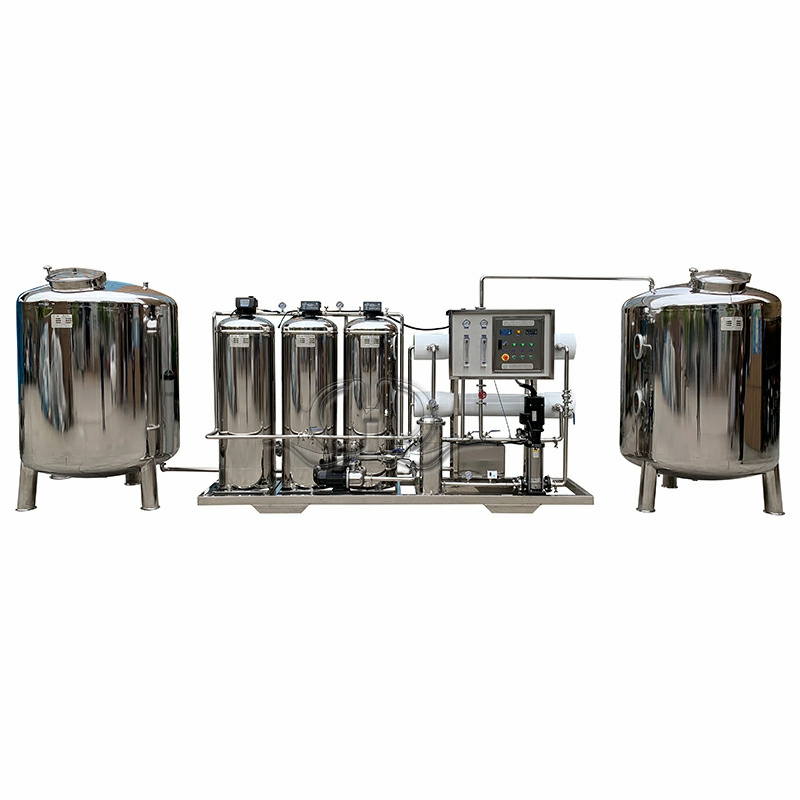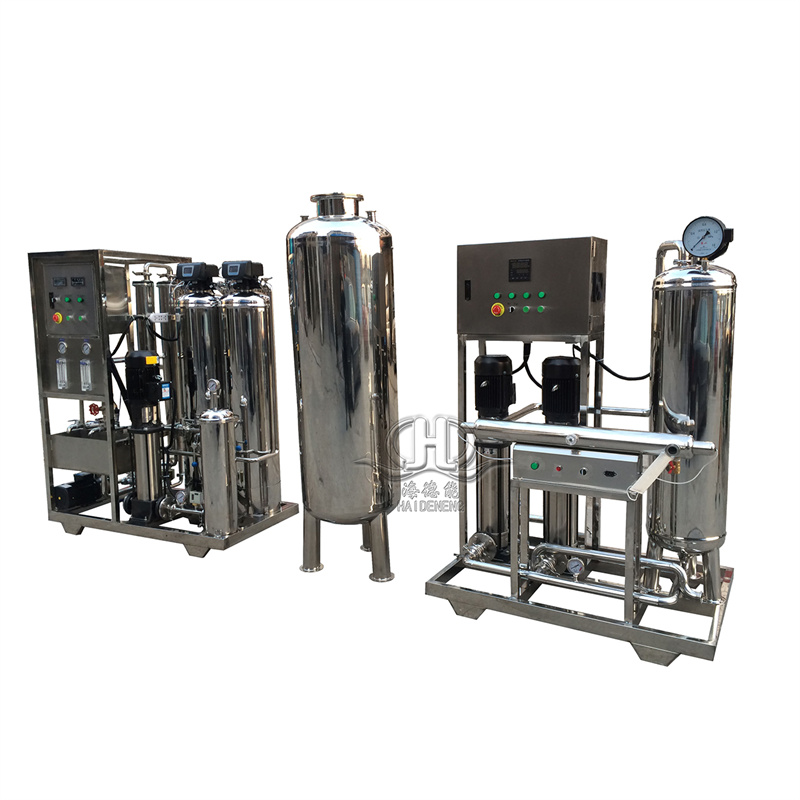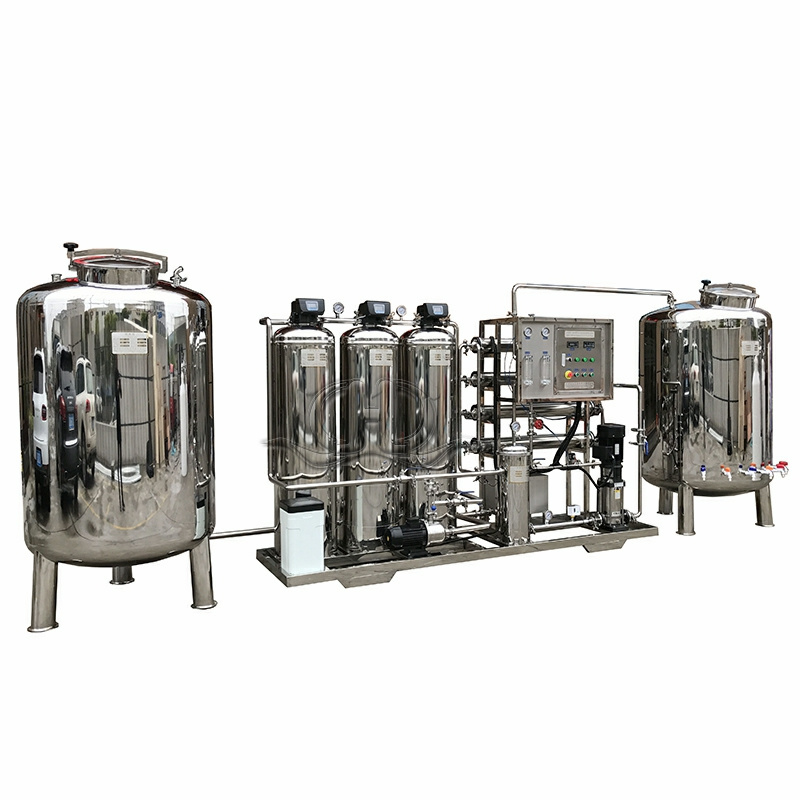Raw Water tank Sand Filter, Carbon Filter, Fine Filter, Fully Automatic Reverse Osmosis with Pure Water tank
Product description
This system is a standardized integrated equipment for pure water preparation. Through the full process design of “pretreatment+reverse osmosis deep purification+water storage”, it converts raw water (such as groundwater, tap water, surface water) into pure water that meets industrial or civilian standards. It is widely used in small and medium-sized water use scenarios (such as laboratories, food processing, small electronic workshops, etc.). The following provides a detailed explanation of the system composition, workflow, core functions, and operational characteristics:
1、 Core components and functions of the system
1. Raw Water Tank
Construction: The material is mostly polyethylene (PE) or stainless steel (304 or 316), equipped with a liquid level sensor, inlet valve, and mixing device (optional).
Core role:
Storage of raw water: Buffer fluctuations in raw water supply (such as unstable tap water pressure and intermittent well water pumping) to ensure continuous water inflow into the subsequent system;
Preliminary homogenization: By stirring (for raw water with uneven water quality) to reduce fluctuations in parameters such as water temperature and turbidity, the pre-treatment effect is stabilized;
Protection of water pump: To prevent damage to the front-end water pump caused by the interruption of raw water flow, and to automatically trigger shutdown protection when the liquid level is too low.
2. Sand Filter
Construction: Pressure bearing filter tank (made of fiberglass or stainless steel), filled with quartz sand of different particle sizes (upper coarse sand, lower fine sand, forming a gradient filter layer), equipped with an automatic backwash valve group.
Core role:
Remove suspended solids (SS) from raw water, such as sediment, rust, algae, colloidal particles, etc;
Reduce the turbidity of water (usually from 10-30NTU to below 1NTU);
To reduce the load on subsequent filtration units (such as carbon filtration and precision filtration) and prevent large particle impurities from clogging or scratching the filter material.
3. Carbon Filter
Construction: The filter tank is filled with granular activated carbon (commonly coconut shell charcoal, which has better adsorption performance than coal charcoal), and some systems are equipped with activated carbon fibers to enhance adsorption efficiency.
Core role:
Adsorption of organic matter (such as pesticide residues, industrial solvents, humic acid), odors, and pigments in water;
Efficient removal of residual chlorine (disinfection residues such as Cl ₂ and HClO in tap water) to prevent oxidation and damage to subsequent reverse osmosis membranes;
Assist in removing some heavy metal ions (such as lead and mercury) and volatile organic compounds (VOCs).
4. Fine Filter
Construction: Security filter (made of stainless steel or PVC material), with built-in PP cotton filter element and folding filter element with precision of 5 μ m or 1 μ m.
Core role:
Retain small particles remaining after pre-treatment (such as activated carbon powder, sand particle fragments, colloidal particles);
As the “last barrier” of the reverse osmosis system, it ensures that the diameter of water particles entering the reverse osmosis membrane is ≤ 5 μ m, preventing the membrane surface from being scratched or blocked, and extending the service life of the membrane.
5. Fully Automatic Reverse Osmosis (RO) device
Core structure:
High pressure pump (providing the required pressure for reverse osmosis, usually 1.0-1.5MPa);
Reverse osmosis membrane module (roll type composite membrane, such as Dow BW30-4040, with a retention rate of ≥ 99%);
Automatic control system (PLC+touch screen, controlling valve opening and closing, pressure regulation, flushing program);
Auxiliary components: flowmeter, pressure gauge, conductivity meter, concentrated water regulating valve.
Core role:
By utilizing the selective permeability of reverse osmosis membranes, only water molecules are allowed to pass through, intercepting over 99% of soluble salts (such as NaCl), heavy metal ions, bacteria, viruses, and large organic molecules;
Fully automatic operation: Real time monitoring of water quality (conductivity), inlet and outlet pressure through sensors, automatic start stop, flushing (such as automatic flushing of membrane surface impurities upon startup), and adjustment of concentrated water ratio;
Produce pure water (with conductivity typically ranging from 5-50 μ S/cm, depending on the quality of the raw water).
6. Pure Water Tank
Construction: Similar to the original water tank, some high-end systems will be equipped with air filters (to prevent microbial contamination of pure water in the air) and ultraviolet sterilizers (to continuously inhibit bacteria during storage).
Core role:
Storage of reverse osmosis water production: balancing the rhythm of water production and use (such as storing water in advance in the water tank during concentrated water use during the day);
Stable water supply pressure: Through the variable frequency water pump at the outlet of the water tank, stable pressure pure water is provided to the terminal water point;
Water quality protection: Avoid secondary pollution caused by long-term standing of pure water (such as equipping a circulation pipeline to slowly circulate pure water).
2、 System workflow
Raw water storage and transportation:
Raw water (such as tap water and well water) first enters the raw water tank. When the liquid level reaches the set value (usually 50%), the system automatically starts the raw water pump and sends the water to the pretreatment unit.
Preprocessing stage:
The raw water is first filtered through a sand filter to remove large suspended particles and colloids, reducing turbidity;
The effluent enters the carbon filter to adsorb organic matter, residual chlorine, and odors;
Subsequently, fine impurities are intercepted through a precision filter to ensure clear water quality (particles ≤ 5 μ m).
Reverse osmosis deep purification:
The pre treated water is pressurized by a high-pressure pump to the working pressure of the reverse osmosis membrane and enters the membrane module:
Water molecules permeate through the membrane to form pure water, which enters the pure water tank;
Salt and impurities that have not penetrated the membrane form concentrated water (the discharge ratio is controlled by a concentrated water regulating valve, usually concentrated water: produced water=1:2-1:3).
The system monitors the conductivity of the produced water in real-time, and automatically discharges unqualified water if it exceeds the standard; When the pressure difference is too large, the membrane flushing program will automatically start.
Pure water storage and supply:
The pure water tank stores standard pure water, and when the terminal water point is turned on, the pure water is transported to the usage point through the water supply pump; When the liquid level in the water tank is too low, the reverse osmosis system automatically starts to replenish water, and when the liquid level is too high, it stops to achieve supply-demand balance.
3、 System operation characteristics and applicable scenarios
Core Features
Fully automatic operation: from raw water inlet to pure water supply, the entire process is controlled by PLC, supporting timed start, liquid level linkage, and automatic fault alarm (such as membrane fouling and filter blockage), without the need for manual duty;
Modular design: Each unit is independent and can be flexibly combined, and can be upgraded according to the quality of the raw water (such as adding a softener for high hardness water) or the demand for water production (such as adding a secondary RO);
Stable water production: Pre treatment fully protects the reverse osmosis membrane, combined with automatic flushing function, the membrane’s service life can reach 2-3 years, and the water quality fluctuation is small (conductivity deviation ≤ 5%);
Easy to operate: Real time viewing of operating parameters (flow rate, pressure, conductivity) through the touch screen, one click start/stop, support for historical data recording and fault query.
Typical Applicable Scenarios
Small scale industries: laboratories (analytical water), cosmetics factories (ingredient water), small electronic workshops (cleaning water);
Commercial fields: catering (beverage production), hospitals (laboratory water), car wash shops (high-purity cleaning water);
Civilian scenarios: villa direct drinking water system, community quality water supply station.
The system achieves efficient and stable conversion from raw water to pure water through a closed-loop design of “raw water buffering → multi-stage pretreatment → reverse osmosis desalination → pure water storage”, making it an economical and practical solution for small and medium-sized pure water demand scenarios. If higher purity water (such as electronic grade ultrapure water) is required, an EDI (Electrodeionization) device can be added on this basis to further reduce the conductivity to below 0.1 μ S/cm.







